|
|
Progress of Relaxor Multiferroic Materials
WEI Yong-Xing, JIN Chang-Qing, ZENG Yi-Ming
2017 Vol. 32 (10): 1009–1017
 Abstract
Abstract(
1351 )
 HTML
HTML(
23)
 PDF
PDF(597KB)(
1621
)
The multiferroic material, which shows the coexistences of multi ferroic orders (ferroelectricity, ferromagnetism or ferroelasticity), can realize the mutual control of the electric and magnetic signals, and becomes one of the hottest research topics. The long-range ferroelectric or ferromagnetic order may be broken in compositionally disordered systems. In this situation, it is posssible that materials display relaxor behavior. Multiferroic materials possessiong at least one ferroic relaxor character can be named as relaxor multiferroics. The polarization (or magnetization) is very sensitive to the applied electric field (or magnetic field). Besides, the magnetoelectric coupling effect of relaxor multiferroics is different from that of multiferroics with long ferroic orders. In this paper, the most recent and important theoretical and experimental advances in this new research field are reviewed. Firstly, basic physical concepts of the relaxor ferroic orders and the different mechanism of the magnetoelectric coupling effect on materials are introduced with the coexistence of relaxor ferroelectric ordering and relaxor magnetic ordering. Then, the recent researches on two sorts of the relaxor multiferroics, including perovskite (PbB1B2O3 based and BiFeO3 based) and non-perovskite (Bi-layered based and improperly ferroelectric based) structural materials, are reviewed. Finally, the further development of relaxor multiferroics is prospected.
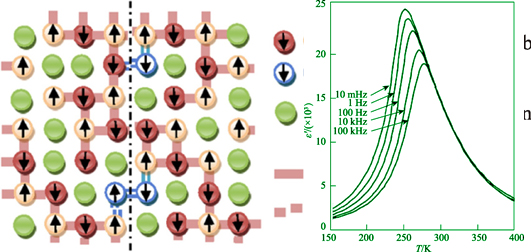
|
|
|
Structure and Property of Bi5Ti3FeO15 Film
HUANG Zhi-Deng, ZHAO Hong-Yang, MA Zhi-Bin, FU Qiu-Ming, TAO Hong, FAN Zi-Ran
2017 Vol. 32 (10): 1018–1022
 Abstract
Abstract(
661 )
 HTML
HTML(
4)
 PDF
PDF(457KB)(
1086
)
Bi5Ti3FeO15 (BTFO15) thin films were grown on Pt/Ti/SiO2/Si substrate by pulsed laser deposition (PLD) method. The structure, magnetic properties, ferroelectric properties, and ferroelectric domains were studied by using X ray diffraction, scanning electron microscopy and scanning TEM high-angle annular dark-field (HAADF STEM). Results showed that the BTFO15 film had high crystallization with perfect layered lattice structure. It stacked like a sandwich which three Bi layers and Ti(Fe)O6 octahedra were sandwiched by two closely stacked Bi layers. In addtion, room-temperature magnetic hystersis loop and ferroelectric hysteresis loop confirmed that the BTFO15 film had weak ferromagnetism and ferroelectricity. The piezo response force microscope was used to study the domain and domain switching, the in-plane and out-of-plane PFM images were obtained by applying the voltage of ±3 V and ±10 V. These results are important to understand the relationship between microstructure and property of multiferroic materials.
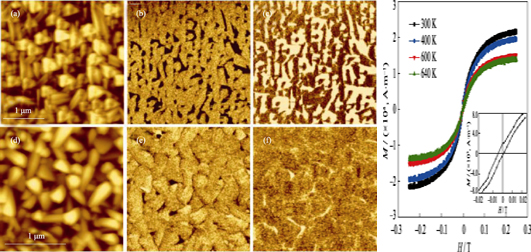
|
|
|
Scalable Preparation and Microwave Absorption of Lightweight Fe3O4/Mesoporous Carbon Microsphere Composites
LIU Ke, WANG Ji-Tong, LONG Dong-Hui, LING Li-Cheng
2017 Vol. 32 (10): 1023–1028
 Abstract
Abstract(
714 )
 HTML
HTML(
10)
 PDF
PDF(651KB)(
1197
)
Fe3O4/mesoporous carbon microspheres (MCMSs) composites were prepared by a facile wet-impregnation method using spray-drying produced MCMSs as carbon substrates. The structure, morphology and microwave absorbing performance were investigated. Results indicate that the composites have good fluidity and low bulk density of 0.24- 0.33 g/m3. The Fe3O4 nanoparticles are homogeneously dispersed in the mesoporous channels without blocking the porosity of MCMSs. The resulting Fe3O4/MCMSs composites have very high BET surface areas of 548-735 m2/g, which promote multiple relaxations. In the frequency range of 2-18 GHz, the microwave loss is primarily derived from dielectric loss. The composite with 40wt% Fe3O4 exhibits a maximum reflection loss of -25 dB at 12.6 GHz and a broad absorption band over 4.7 GHz. Such good microwave electromagnetic performances can be ascribed to the synergistic effects of highly dispersed Fe3O4 nanoparticles and mesoporous channels, which can increase interfacial relaxation and microwave diffraction as well as reduce the reflection of microwave at the interface between air and absorber.
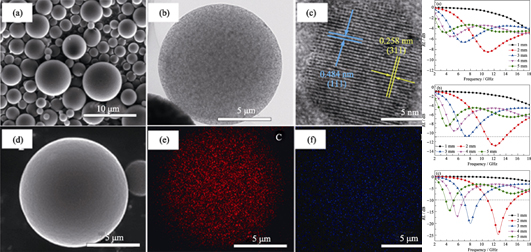
|
|
|
High Dielectric-permittivity Properties and Relevant Mechanism of NaCu3Ti3Sb0.5Nb0.5O12 Ceramics
YANG Shuai, XU Pan-Pan, WANG Ming-Wen, HAO Wen-Tao, SUN Li, CAO En-Si, ZHANG Yong-Jia
2017 Vol. 32 (10): 1029–1035
 Abstract
Abstract(
570 )
 HTML
HTML(
3)
 PDF
PDF(562KB)(
1286
)
A series of NaCu3Ti3Sb0.5Ta0.5O12 ceramics were prepared by conventional solid-state reaction technique at different sintering temperatures. Their crystalline structures, microstructures, dielectric properties and complex impedance were systematically investigated. All the ceramics show the main phase of perovskite-related crystallographic structure, and their dielectric properties change significantly with sintering temperature. Those ceramics sintered above 1020°C perform high dielectric-permittivity properties with ε' over 3000. Impedance spectroscopy analysis reveals that NaCu3Ti3Sb0.5Ta0.5O12 ceramics are electrically heterogeneous and composed of semiconducting grains and insulating grain boundaries. Moreover, a small amount of CuO secondary phase and Cu2+/Cu+, Ti4+/Ti3+, Sb5+/Sb3+ and Ta5+/Ta3+ aliovalences are found to exist in NaCu3Ti3Sb0.5Ta0.5O12 ceramics through XRD and XPS analysis. Internal barrier layer capacitance effect suggests the origin of the high dielectric-permittivity properties in NaCu3Ti3Sb0.5Ta0.5O12 ceramics.
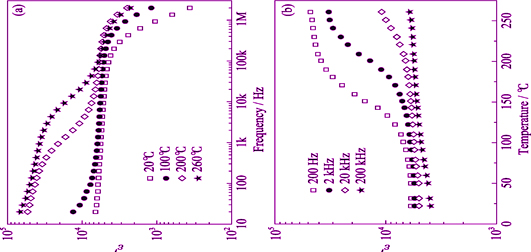
|
|
|
Excess Bi and Cooling Method on Phase Structure and Electrical Properties of BiFeO3-BaTiO3 Lead-free Ceramics
MA Jian, ZHANG Bo-Ping, CHEN Jian-Yin
2017 Vol. 32 (10): 1035–1041
 Abstract
Abstract(
733 )
 HTML
HTML(
9)
 PDF
PDF(711KB)(
1234
)
A series of 0.7BiFeO3-0.3BaTiO3-xBi2O3(0≤x≤0.05) ceramics were prepared with solid reaction method under furnace, air and water cooling. The effects of excess Bi and cooling methods on phase structure, morphology and comprehensive electrical properties were investigated. All the ceramics show coexisting R-PC phase whose ratio CR/CPC is close to 1 at x = 0.01, apart from the appearance of an impurity phase Bi25FeO40 when x>0.01. Compared with cooling way, optimizing excess Bi content is more beneficial to enhance the piezoelectric performance of BFBT-xBi2O3. The d33 firstly increases and then decreases with x increment, and gets an optimal value at x = 0.01. Smaller grain size and suitable CR/CPC, larger residual strain all contribute to the enhanced piezoelectricity (d33=141 pC/N, kp=27%) and a high Curie temperature (TC = 507℃) in water-cooled BFBT-0.01Bi2O3 ceramic. The present work indicates that BFBT based lead-free piezoelectric ceramics are promising candidates for high temperature applications with both high performance and high TC.
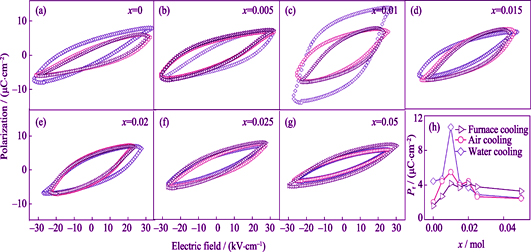
|
|
|
Graphene Quantum Dots/CdS/CdSe Co-Sensitized Solar Cells
LIU Yong-Qiang, HUANG Hao, ZHAI Jin-Sheng, MA Meng-Jun, FAN Jia-Jie
2017 Vol. 32 (10): 1042–1048
 Abstract
Abstract(
900 )
 HTML
HTML(
5)
 PDF
PDF(608KB)(
1689
)
Using three-dimensional anatase TiO2 microspheres as light scattering overlayer and commercial TiO2 nanocrystalline as connecting underlayer, novel double-layered TiO2 films were prepared by a doctor blade method for quantum dots sensitized solar cell (QDSSC) application. The graphene quantum dots (GQDs) were introduced by dripping, and the CdS/CdSe quantum dots were deposited by continuous ion-layer adsorption (SILAR) method, respectively. The prepared quantum dots sensitized thin films were characterized by field emission scanning electron microscopy, transmission electron miscroscopy, X-ray diffraction, Uv-vis diffuse reflectance spectra, and fluorescence spectra. CdS/CdSe quantum dots sensitized and GQDs/CdS/CdSe co-sensitized solar cells were fabricated, respectively. And the effects of GQDs and CdS quantum dots with different deposition cycles on the microstructures and the photovoltaic performance of the double-layered TiO2 QDSSCs were investigated and discussed. The results revealed that the introduced GQDs and the CdS deposition cycle obviously influenced the optical properties of the double-layered TiO2 film. The electron transfer and charge-recombination process are also affected by the CdS deposition cycle and the introduced GQDs. Optimally, the conversion efficiency and photocurrent density of the TiO2/QGDs/CdS(4)/CdSe solar cell is 1.24% and 9.47 mA/cm2, respectively, which are higher than those (0.59% and 6.22 mA/cm2, respectively) of the TiO2/CdS(4)/CdSe cell. This is due to the effective electrons transport and reduced charge recombination within the co-sensitized cell.
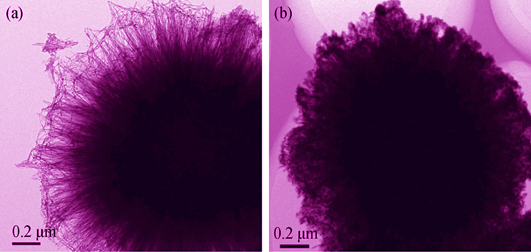
|
|
|
Dye-sensitized Solar Cells Based on Double-layer Composite Film with Enhanced Photovoltaic Performance
RAN Hui-Li, HUANG Hao, MA Meng-Jun, ZHAI Jin-Sheng, FAN Jia-Jie
2017 Vol. 32 (10): 1049–1054
 Abstract
Abstract(
552 )
 HTML
HTML(
3)
 PDF
PDF(497KB)(
1018
)
Dye-sensitized solar cells (DSSCs) were fabricated using TiO2 nanorod arrays as underlayer and hybrid nanosheets-microspheres as overlayer, where 1 dimensional TiO2 nanorod arrays, 2 dimensional TiO2 nanosheets, and 3 dimensional TiO2 microspheres were prepared by hydrothermal method. Nanosheets/microspheres hybrid structures with different weight ratios were fabricated in order to study the structural effect of photoanodes on the solar cell performance. The samples were characterized by field emission scanning electron microscope, N2 adsorption-desorption isotherms, X-ray diffraction, UV-Vis diffuse reflectance spectra, photoluminescence (PL) spectra, and electrochemical impedance spectroscope. The results showed that both optical and electrical properties of photoanodes and photovoltaic performances of DSSCs were obviously influenced by the weight ratios of nanosheets/microspheres. It was found that the electrode made from 50wt% nanosheets had the largest dye-loading, highest light absorption, smallest inherent resistance, and lowest PL intensity, comparing with those made from other weight ratios of nanosheets. The performances of DSSCs made from 25wt%, 50wt%, 75wt%, and 100wt% nanosheets double-layered electrodes were studied in detail, with corresponding efficiencies of 1.46%, 1.71%, 1.26%, and 1.13%. This can be ascribed to that the cell made from 50wt% nanosheets has strong light absorption, reduced carrier recombination rate, and enhanced electrons transport.
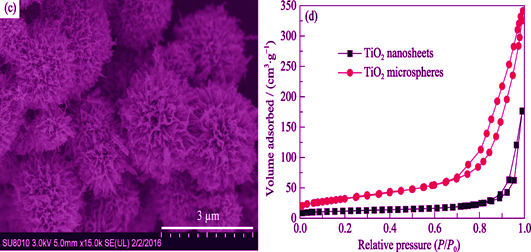
|
|
|
Optimal Principle on Composition of B Site Elements in Perovskite Electrodes with Sr at A Site for Solid Oxide Fuel Cell
CHANG Xi-Wang, CHEN Ning, WANG Li-Jun, LI Fu-Shen, BIAN Liu-Zhen, CHOU Kuo-Chih
2017 Vol. 32 (10): 1055–1062
 Abstract
Abstract(
634 )
 HTML
HTML(
6)
 PDF
PDF(496KB)(
1547
)
Based on ab inito method, the binding energies of SrBO3 perovskite type electrode materials in solid oxide fuel cell in which B site chosen from 3rd to 6th periods elements were calculated. Effect of elements used in B site on the formation of cubic or hexagonal crystal structure was discussed. Structure stability diagram that contained three phases (unstable, cubic stable and hexagonal stable phases) was achieved. The distribution rule of composition points in this diagram was confirmed by inducing radius and valence data of cations at B site as validation data. Besides, there being plenty of experimental materials data in literature was introduced to this structure stability diagram, according to their compositions and lever rule. Distribution area of the obtained data was analysed and the results locate quite concentrated, indicating that the optimized area is centered by along the Mo-Fe-Co line. Within this area, our calculations find that formation energy and migration energy of oxygen vacancy as well as the band gap of the materials are suitable to be used as electrode materials in solid oxide fuel cell. The optimization area in SrBO3 structure stability diagram can provide meaningful guidance for material selection.
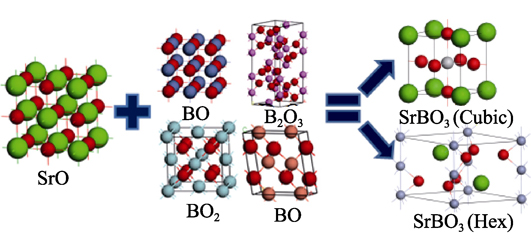
|
|
|
Preparation and Characterization of a Novel Hybrid Perovskite (HOC2H4NH3)2CuCl4
YANG Zhi-Sheng, KE Wei-Fang, WANG Yan-Xiang, HUANG Li-Qun, GUO Ping-Chun, ZHU Hua
2017 Vol. 32 (10): 1063–1067
 Abstract
Abstract(
691 )
 HTML
HTML(
17)
 PDF
PDF(420KB)(
1157
)
A novel organic-inorganic hybrid material containing hydroxyl, (HOC2H4NH3)2CuCl4 with perovskite structure, was synthesized by low-temperature solution method. The structure and properties of the hybrid material were characterized by elemental analysis, IR, UV-Vis absorption spectrum, X-ray diffraction, and X-ray absorption fine structure techniques. The result reveals that the hybrid material (HOC2H4NH3)2CuCl4 is well-ordered and in two-dimensional layered frame, and the organic component is in orderly arrangement induced by inorganic framework. The decomposition temperature of the hybrid material is about 212℃, and the resistance of the hybrid material is about 2.86×106 Ω·cm, which is two orders of magnitude less than hybrid perovskite without hydroxyl. UV-Vis spectra shows that the crystal has a new absorption peak at about 285 nm which is attributed to the electronic transitions from the top of the valence band of Cl (3p) to the bottom of the conduction band of Cu (4s). XAFS result shows that Cu2+ with six Cl- forms octahedral coordination in the hybrid layered crystal with layer spacing of 1.099 nm, and the Cu-Cl bond length is about 0.191 nm.
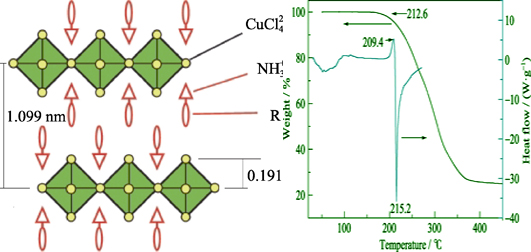
|
|
|
Spinel AFe2O4 Catalysts: Preparation and Catalytic Combustion of Toluene
WANG Yong-Qiang, XUE Rui, ZANG Meng, LIU Min-Min, CHEN Xi, ZHAO Chao-Cheng
2017 Vol. 32 (10): 1068–1074
 Abstract
Abstract(
893 )
 HTML
HTML(
16)
 PDF
PDF(552KB)(
1335
)
Nanocrystalline AFe2O4(A=Cu, Co, Ni, Mg, Zn) ferrite spinel catalysts were prepared by Sol-Gel auto-combustion method. In order to investigate the influence of A sites in AFe2O4 spinel catalysts, the catalytic combustion of toluene was investigated, and the catalysts were characterized by XRD, N2 adsorption-desorption, SEM, TEM, H2-TPR, and XPS. It was found that AFe2O4 catalysts have excellent catalytic activity. Among the catalysts, the CuFe2O4 catalyst obtains the highest catalytic activity, and its light-off temperature (T50) and the complete combustion temperature (T90) of toluene were 188℃ and 239℃, respectively. And AFe2O4 catalysts have obviously lamellar spinel crystal structure and the multilevel pore structures with prevalence to mesoporous, which will improve the catalytic activity of the catalysts. It is concluded that the elements of A site on AFe2O4 have great influence on catalytic combustion activity. The H2 reduction temperature is only 289℃, when A site was occupied by Cu. CuFe2O4 has crystal lattice volume of 0.294 nm3 with CuO and α-Fe2O3 formed in the crystal. The concentration of electrophilic oxygen and oxygen vacancy in all oxygens (Oele/O1S) is 36%. Lamellar trans spinel crystal lattice, the synergies of trans spinel CuFe2O4 with CuO and α-Fe2O3, and the multilevel pore structures with prevalence to mesoporous are the main reasons for the catalytic activity improvement of CuFe2O4.
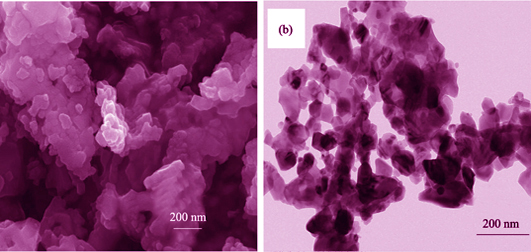
|
|
|
Preparation and Electrocatalytic Property of Pt/{GN/CuPW11}n Composite Films toward Methanol Oxidation
ZHANG Yi, ZHANG Xiao-Feng, He Xiao-Lei, HUANG Huo-Di, LE Li-Juan, LIN Shen
2017 Vol. 32 (10): 1075–1082
 Abstract
Abstract(
401 )
 HTML
HTML(
3)
 PDF
PDF(729KB)(
782
)
Composite films consisting of graphene and CuPW11 polyoxometalates {GN/CuPW11}n, were prepared by layer-by-layer (LBL) assembly and used as a support for electro-deposition of Pt nanoparticles by cyclic voltammetry. The component and surface morphology of the multilayer composite films were characterized by AFM, SEM, XRD and XPS. The results indicate that {GN/CuPW11}4 composite multilayer films exhibit even and uniform distribution and Pt nanoparticles on the surface of {GN/CuPW11}4 composite multilayer films display flower-like cluster shape. Pt in the Pt/{GN/CuPW11}4 composite multilayer films mainly exists in the form of Pt(0) but some exists in the form of Pt(Ⅱ) and Pt(Ⅳ). The electrocatalysis experiment results show that introduction of CuPW11 evidently improves electrocatalytic activity, stability and CO tolerance ability of Pt/graphene composite catalysts toward methanol oxidation.
|
|
|
Ultrasonic-Vibration-Assisted Laser Annealing on Photoelectric Properties of FTO Thin Films
REN Nai-Fei, CAO Hai-Di, HUANG Li-Jing, LI Bao-Jia, ZU Wei
2017 Vol. 32 (10): 1083–1088
 Abstract
Abstract(
849 )
 HTML
HTML(
5)
 PDF
PDF(618KB)(
1072
)
A novel way, i.e. introducing ultrasonic vibration during the laser annealing process, was developed for treating fluorine-doped tin oxide (FTO) transparent conducting thin films. The influences of ultrasonic-vibration-assisted laser annealing on crystal structure, surface morphology and photoelectric properties of the FTO films were investigated. The experimental results indicated that application of ultrasonic vibration during laser annealing caused the films to move up and down and thus brought about a continuous change in laser focusing state, ensuring the films to be in the optimum location to undergo laser annealing. Meanwhile, it could enable the particles in the laser-molten zone on the film surfaces to be dispersed through vibration, thus restraining the agglomeration of the particles and enhancing the uniformity and compactness of the films. As a result, photoelectric properties of the FTO films were effectively improved. It was found that the FTO film obtained by using a vibration power of 300 W was more uniform, compact and smooth, thereby yielding the optimal photoelectric properties with an average optical transmittance of 84.7% in the waveband range of 400~800 nm and a sheet resistance of 9.0 Ω/□.
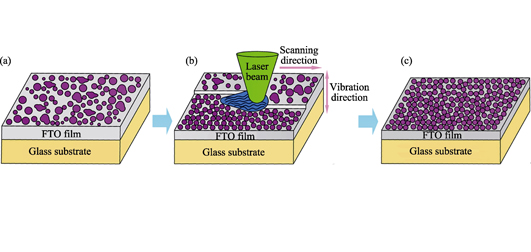
|
|
|
La0.8Sr0.2(Ga0.8Mg0.2)0.1Fe0.9O3-δ Dense Diffusion Barrier Limiting Current Oxygen Sensor Prepared by Co-pressing and Co-sintering Method
ZHANG Xiao-Fang, LIU Tao, JIN Hong-Bin, YU Jing-Kun, GAO Xiang, WANG Cheng, WANG Xiang-Nan
2017 Vol. 32 (10): 1089–1094
 Abstract
Abstract(
625 )
 HTML
HTML(
4)
 PDF
PDF(642KB)(
981
)
The La0.8Sr0.2(Ga0.8Mg0.2)0.1Fe0.9O3-δ (LSGMF) mixed conductor and La0.8Sr0.2Ga0.8Mg0.2O3-δ (LSGM) solid electrolyte were prepared by solid-state reaction and characterized by XRD, TGA, Van Der Pauw dc four-probe method, and thermal expansion measurement. A limiting current oxygen sensor with LSGMF as a dense diffusion barrier and LSGM as a solid electrolyte was prepared by a co-pressing and co-sintering method. The microstructure and composition of LSGMF/LSGM cross-section were analyzed by SEM and EDS. The results show that crystal structure of LSGMF is rhombohedral perovskite which belongs to R-3c space group. Its weight loss rate is the fastest at about 650℃. The electrical conductivity increases with the temperature increasing. The thermal expansion coefficients (TECs) of LSGM and LSGMF are 12.51×10-6/℃ and 12.80×10-6/℃ in the range of 300-1000℃, respectively. In the range of 650-850℃, the sensor exhibits an excellent limiting current plateau. lgIL (limiting current) depends linearly on 1000/T, and the activation energy for oxide-ion diffusion in LSGMF is 0.4008 eV. The limiting current responses depend linearly on the oxygen concentration at 800℃ and 0.3mol% < x (O2) < 21.0mol%, i.e., IL (mA) = 10.285x (O2) (mol%), R=0.9982. LSGMF and LSGM combines firmly without crack, and the mole ratio of their elements is basically in agreement with the stoichiometric of LSGMF and LSGM.
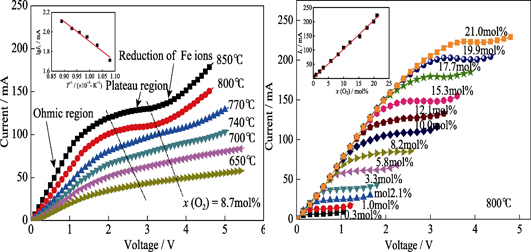
|
|
|
HfC Precursor: Synthesis and Pyrolysis Behavior
ZHANG Cheng, GONG Jun-Jie, DONG Zhi-Jun, MENG Jian, ZHOU Si-Cheng, YUAN Guan-Ming, LI Xuan-Ke
2017 Vol. 32 (10): 1095–1101
 Abstract
Abstract(
819 )
 HTML
HTML(
9)
 PDF
PDF(538KB)(
1130
)
Hafnium carbide ceramic powders were prepared by pyrolysis of a novel precursor, which was synthesized via one pot method using hafnium tetrachloride, acetylacetone, methanol, and hydroquinone as raw materials. The composition, morphology and microstructure of the pyrolysis products were characterized by XRD, FTIR, SEM/EDS, TEM, and SAED. The pyrolysis behavior of the obtained HfC precursor was investigated by TG-DSC and TG-MS. The results show that the ceramization of the HfC precursor starts at about 600℃, and the formation of HfC ceramics is initiated at about 1300℃. At temperature above 1500℃, the precursor completely transforms into HfC ceramics and free carbon. The as-obtained HfC phase has a single crystal structure and the size of the HfC particles ranges from 50 to 100 nm. Formation of the HfC ceramics can be attributed to the carbothermal reduction reaction of the HfO2, which is produced by pyrolysis of the precursor at a relative low temperature. The growth of the HfC crystals is retarded by free carbon formed during pyrolysis of the precursor.
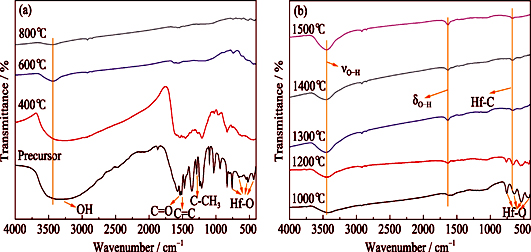
|
|
|
Structure and High-temperature Wear Behavior of Zr Modified Silicide Coatings Prepared on TC4 Alloy
LI Xuan, TIAN Jin, TIAN Wei, XIE Wen-Ling, LI Xiu-Lan
2017 Vol. 32 (10): 1102–1108
 Abstract
Abstract(
633 )
 HTML
HTML(
3)
 PDF
PDF(575KB)(
887
)
Zr modified silicide coatings were prepared on TC4 alloy by Si-Zr co-deposition, the wear behavior of the coatings were investigated at 600℃, and the wear mechanisms were discussed. The results show that the obtained coating has a multi-layer structure, consisting of a (Ti, X)Si2 (X represents Zr, Al and V elements) outer layer, a TiSi middle layer and an inner layer composed of a mixture of Ti5Si4+Ti5Si3. Addition of Zr in the pack mixtures can reduce the residual stress in the coating by lowering the coating growth rate, leading to a more compact coating structure. The micro-hardness of the coating is obviously higher than that of TC4 alloy, which shows a decrease tendency from the coating surface to its substrate. The high temperature wear tests reveal that the Zr modified silicide coating can offer effective protection for TC4 alloy at high temperatures. When using GCr15 ball as the counterpart, very slight wear occurred on the worn surface of the coating, and the main wear manners should be the transfers of GCr15 to the coating surface besides a certain extent of oxidation wear. Sliding against Al2O3 ball, the main wear mechanisms of the coating are considered to be plough wear, fatigue wear, adhesive wear, and oxidation wear.
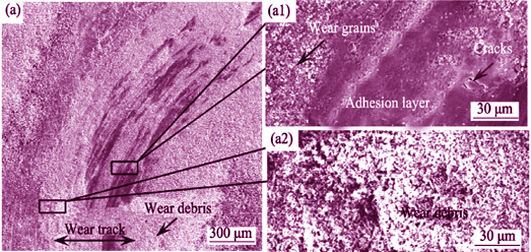
|
|
|
Surface Modified Alumina Particles and Their Chemical Mechanical Polishing (CMP) Behavior on C-plane (0001) Sapphire Substrate
WANG Wei-Lei, LIU Wei-Li, BAI Lin-Sen, SONG Zhi-Tang, HUO Jun-Chao
2017 Vol. 32 (10): 1109–1114
 Abstract
Abstract(
913 )
 HTML
HTML(
11)
 PDF
PDF(433KB)(
1339
)
To improve the Chemical Mechanical Polishing (CMP) performance of alumina particles in aqueous solution, a suitable modification method was explored. Meanwhile, in order to improve their chemical mechanical performance, alumina particles were surface modified with N-(2-aminoethyl)-3-aminopropyltrimethoxysilane through silanization chemical reaction with their surface hydroxyl groups and complexation with Al and secondary amine. This work gives a detailed and thorough chemical reaction mechanism that N-(2-aminoethyl)-3-aminopropyltrimethoxysilane grafted onto the surface of alumina. The compositions and structures of the modified alumina particles were characterized by Fourier transform infrared spectroscopy (FTIR), and X-ray photoelectron spectroscopy (XPS). The results supported that the N-(2-aminoethyl)-3-aminopropyltrimethoxysilane was perfectly grafted onto the surface of alumina particles, which led to the modified alumina particles with better surface chemical and mechanical properties than unmodified alumina particles. Then, CMP performance of the unmodified and modified alumina particles on the sapphire substrate was tested. The results showed that the modified alumina particles exhibited higher material removal rate (MRR) and better surface quality than unmodified alumina particle. The focus is that the modified alumina particles manifested higher MRR at pH 10.00 than the unmodified alumina particles at PH 13.00, which may open a way to reduce corrosion of equipment.
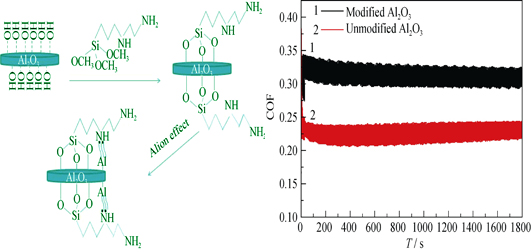
|
|
|
Synthesis of AlN Powder by Carbothermal Reduction-nitridation of Alumina/Carbon Black Foam
MAO Xi-Xi, LI Jun, ZHANG Hai-Long, XU Yong-Gang, WANG Shi-Wei
2017 Vol. 32 (10): 1115–1120
 Abstract
Abstract(
813 )
 HTML
HTML(
7)
 PDF
PDF(702KB)(
1620
)
Alumina/carbon black foam was prepared by mechanical foaming and aqueous gelcasting and used as precursor for the production of AlN powder. The foam with large open pores ensures homogeneous solid-gas reaction during carbothermal reduction-nitridation (CRN) process. Further, the solid-gas contact is enlarged by oppositely feeding the foam and nitrogen in a vertical furnace. Solid-gas reaction efficiency of the CRN process was greatly enhanced when total porosity of the foam was ≥80%. XRD results revealed that γ-Al2O3 transformed to α-Al2O3 and then was carbothermal reduction-nitridationed to be AlN phase. AlN powder with an average particle size of less than 1 µm was synthesized at 1650℃ and contained 32.9wt% nitrogen.
|
|